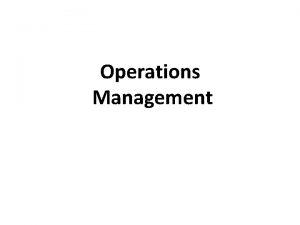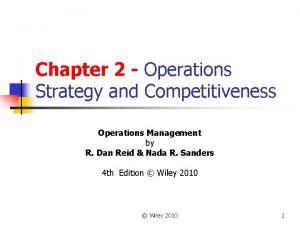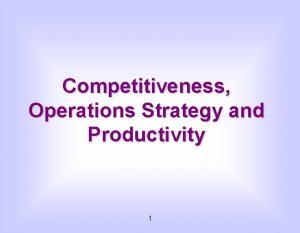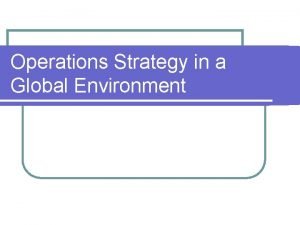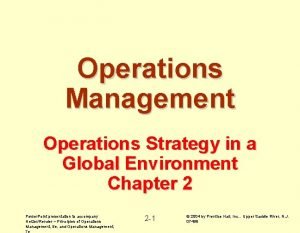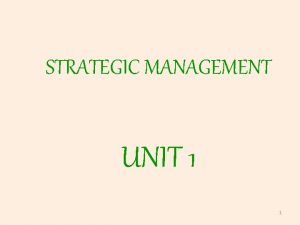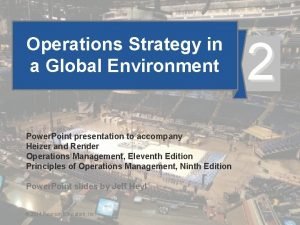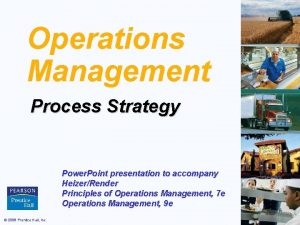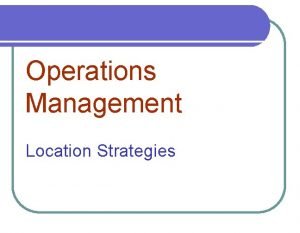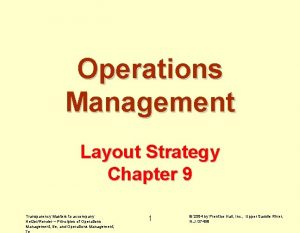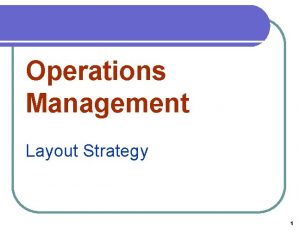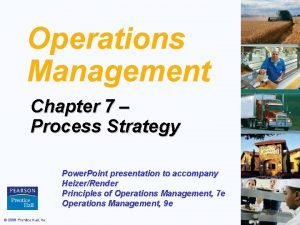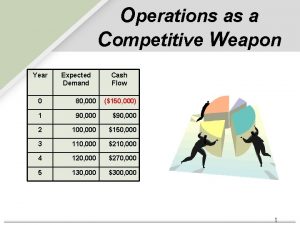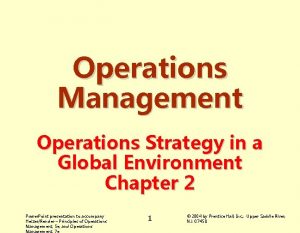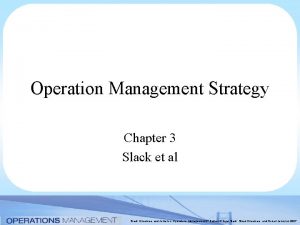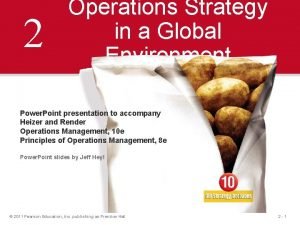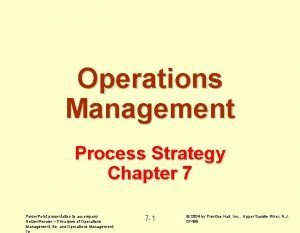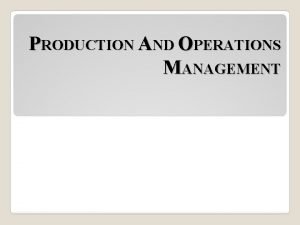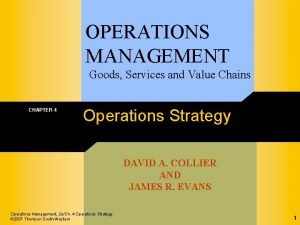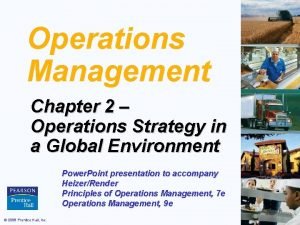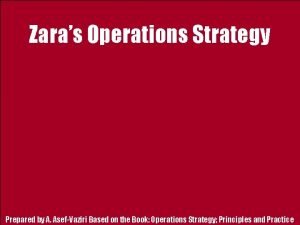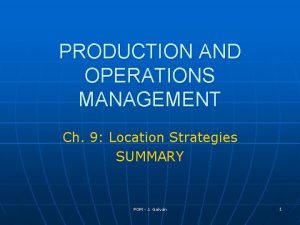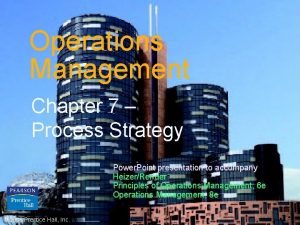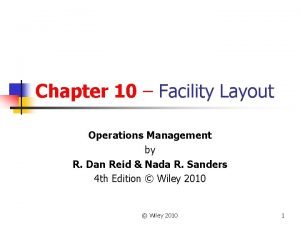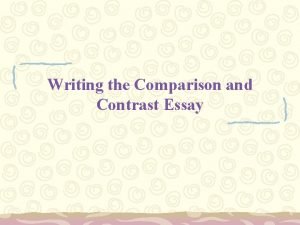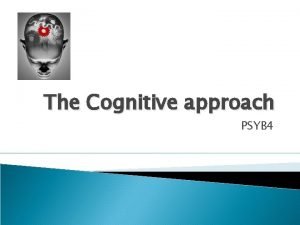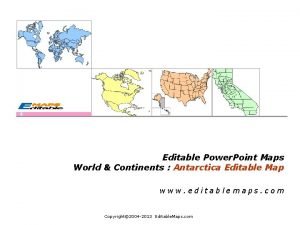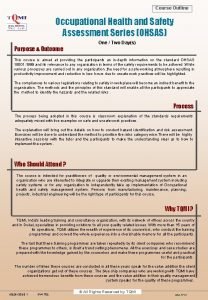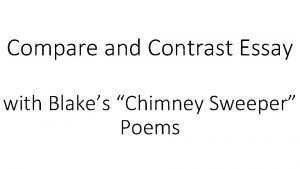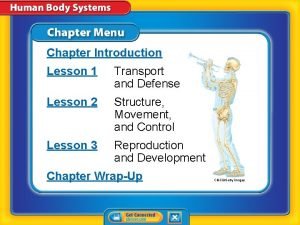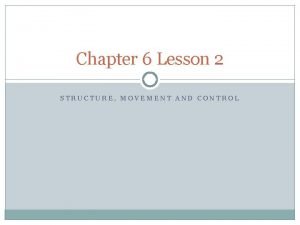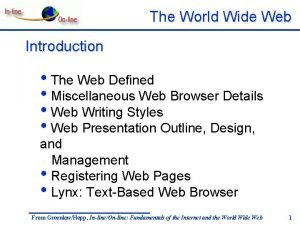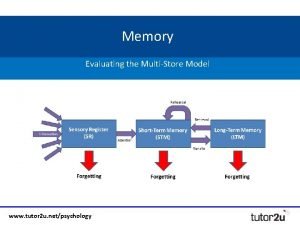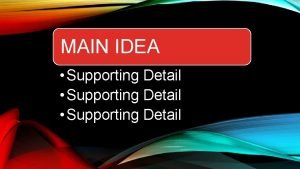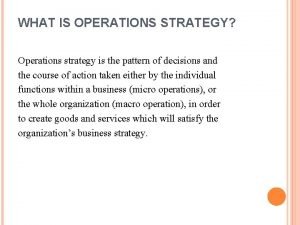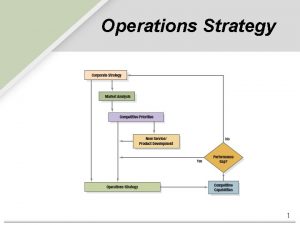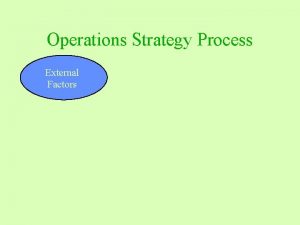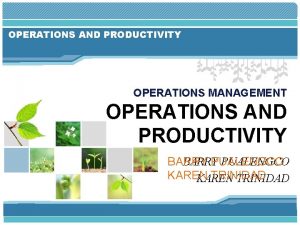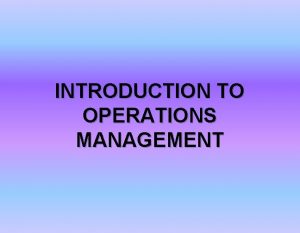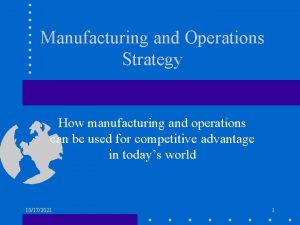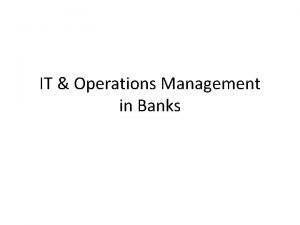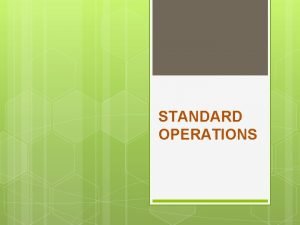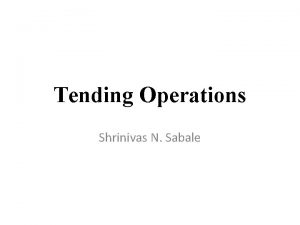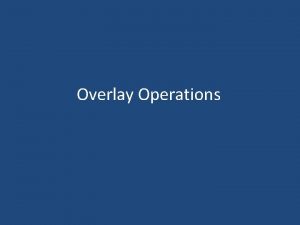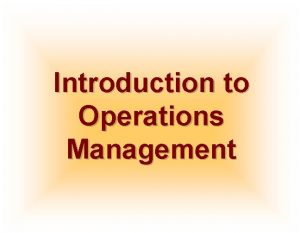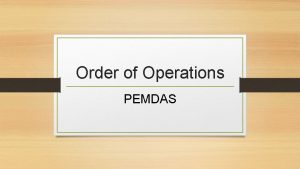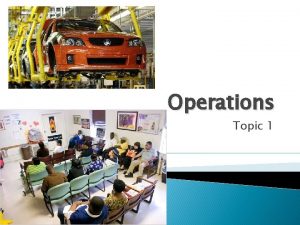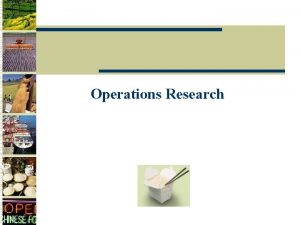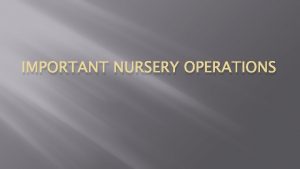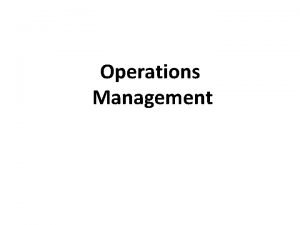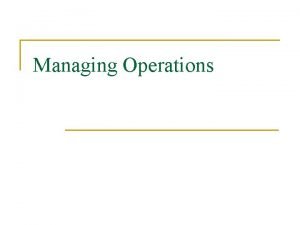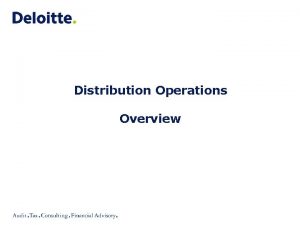Outline Strategy and Operations Strategy p Operations strategy















































- Slides: 47



Outline Ø Strategy and Operations Strategy p Ø Operations strategy content p p Ø Competing through Operations Competitive Dimensions Elements of Operations Strategy A Framework for Manufacturing Strategy p Fit

1. Strategy and Operations Strategy Ø What is Strategy? Ø What is Competitive Strategy? Ø What is Operations Strategy?

What is Strategy? Ø Ø In military, strategy is about the victory in the war, Attack and defending~~~ Strategy is about positioning, finding right position in the market, then targeting them (M Porter: HBS, 1996)

Strategy Hierarchy Ø Ø Ø Corporate Strategy Competitive Strategy Functional Strategy p p Operations Strategy Marketing strategy Finance strategy … Corporate Business Functional Operational

Strategy Corporate Strategy Competitive Strategy Supply Chain Strategy

Corporate strategy Ø Ø Ø Overall strategy adopted by the firm that defines the specific businesses in which the firm will compete and the way in, which resources are, acquired and allocated. Vision Mission Statement

What is Competitive Strategy? Ø Competitive strategy p Defines, relative to competitors, a company’s set of customer needs that it seeks to satisfy through its products and services u Wal-Mart n u Coors n u Everyday low prices (low cost retailer for a wide variety of products) The coldest tasting beer in the world, brewed with Rocky Mountain spring water Dell n Custom-made computer systems at a reasonable cost How do you execute your competitive strategy?

Business Strategy is About Competition Ø Ø Business Strategy= competitive strategy What to compete? Customers Value Firm Cost and differentiation Competitor

Ø Competitiveness p The attractiveness of the product it supplies in the marketplace relative to its competition.

Types of Business Strategies

Ø Functional Strategies p Ø Strategy developed by a function (e. g. , marketing) within an organization to support the business strategy. Operations Strategy p p One of functional strategies A setting broad policies and plans for using the resources of firm to best support its long term competitive strategy.

Competitiveness Dimensions: Product Attributes Ø Ø Pro. Price (Cost) P Pro. Quality Q p Ø Pro. Delivery D p Ø Product features, performance, reliability Rapid, reliable delivery “order winners” Pro. Variety V p Degree of customization To deliver we need “capabilities”

Dealing with Trade-offs and Priorities Ø Ø Order qualifiers are the basic criteria that permit the firm’s products to be considered as candidates for purchase by customers Order winners are the criteria that differentiate the products and services of one firm from another

Positive Orderwinners Competitive benefit Less important Neutral Negativ e Low Qualifiers Achieved performance Order-winners and qualifiers High

Service Breakthroughs Ø A brand name car can be an “order qualifier” Ø Repair services can be “order winners” p Examples: Warranty, Roadside Assistance, Leases, etc.

Capability Dimension: Process Attributes Ø Measuring the ability of processes to produce and deliver corresponding product attributes: p p Cost: the total cost incurred in producing and delivering outputs. Flow Time: the total time needed to transform a flow unit from input into output. Consistency: the ability to produce and deliver quality products. Flexibility: the ability to produce and deliver desired product variety.

Dealing with Trade-offs and Priorities For example, if we reduce costs by reducing product quality inspections, we might reduce product quality. For example, if we improve customer service problem solving by crosstraining personnel to deal with a wider-range of problems, they may become less efficient at dealing with commonly occurring problems. Cost Flexibility Time Quality

Ø Factory Focus and Trade-offs p A factory could not focus on all four competitive priorities (cost, quality, time, and flexibility). u Ø Focusing performance on one dimension limits/eliminates the ability to focus on another priority. Plant-within-a-Plant (PWP) concept (Skinner) p Different locations with a facility would focus on their own competence dimension

Example of Trade-Offs on Superior Performance Curves

Elements of Operations Strategy Ø Operations Strategy p Ø Determining how to best utilize the firm’s resources to build (core) competences, capabilities and gain competitiveness in the market. Structure p p Capacity Facilities Technology Make-Buy or Vertical Integration u Infrastructure – Workforce – Quality – Work Control – Organization Source: Hayes and Wheelwright, Manufacturing Strategy

What is Supply Chain Strategy? Ø Supply chain strategy p Given a competitive strategy, what should a company’s supply chain do particularly well? u Wal-Mart n n u Everyday low prices (low cost retailer for a wide variety of products) Buys from low cost producers, owns its infrastructure and distribution network Competitive Strategy Dell n n Custom-made computer systems at a reasonable cost Online ordering, no middle-man Supply Chain Strategy Competitive Strategy Supply Chain Strategy

What is Strategic Fit? Ø Strategic fit p p Ø Both the competitive strategy and the supply chain strategy have aligned goals Matching customer needs with supply chain capabilities How is strategic fit achieved? 1. 2. 3. Understanding the customer and supply chain uncertainty Understanding the supply chain capabilities Achieving strategic fit

Questions Ø Which supply chain will you choose? p p M L Fisher. What Is the Right Supply Chain for Your Product? Harvard Business Review. 1997 Hau Lee. Aligning Supply Chain Strategies with Product Uncertainties, ", California Management Review, 44, 3 Spring, 2002, pages 105 -119




Functional Versus Innovative Products: Differences in Demand Aspects of Demand Functional (Predictable Demand) Innovative (Unpredictable Demand) Product Life Cycle More than 2 years Contribution Margin* 5% to 20% Low (10 -20 variants per Product Variety category) Average margin of error in the forecast at 10% the time production is committed Average stockout rate 1% to 2% Average forced endof-season markdown 0% as percentage of full price Lead time required for made-to-order 6 months to 1 year products 3 months to 1 year 20% to 60% High (often millions of variants per category) 40% to 100% 10% to 40% 10% to 25% 1 day to 2 weeks *The contribution margin equals price minus variable cost divided by price and is expressed as a percentage.






Understanding the Supply Chain Ø Ø Ø How does the firm best meet demand? Dimension describing the supply chain is supply chain responsiveness Supply chain responsiveness -- ability to p p p respond to wide ranges of quantities demanded meet short lead times handle a large variety of products build highly innovative products meet a very high service level

Understanding the Supply Chain Ø Ø Ø There is a cost to achieving responsiveness Supply chain efficiency: cost of making and delivering the product to the customer Increasing responsiveness results in higher costs that lower efficiency

Understanding the Supply Chain: Cost-Responsiveness Efficient Frontier Responsiveness High E B D C A Low High Low Cost

Physically Efficient Versus Market-Responsive Supply Chains Primary Purpose Manufacturing focus Inventory strategy Lead-time focus Approach to choosing suppliers Product-design strategy Physically Efficient Process Supply predictable demand efficiently at the lowest possible cost Market-Responsive Process Respond quickly to unpredictable demand in order to minimize stockouts, forced markdowns, and obsolete inventory Maintain high average Deploy excess buffer capacity utilization rate Generate high returns and Deploy significant buffer stocks of minimize inventory throughout parts or finished goods the chain Shorten lead time as long as it doesn't increase cost Select primarily for cost and quality Maximize performance and minimize cost Invest aggressively in ways to reduce lead time Select primarily for speed, flexibility, and quality Use modular design in order to postpone product differentiation for as long as possible


Matching Supply Chains with Products




Achieving Strategic Fit Ø Strategic fit p Given a competitive strategy, what should a company’s supply chain do particularly well? u Wal-Mart n n u Coors n n u Everyday low prices (low cost retailer for a wide variety of products) Buys from low cost producers, owns its infrastructure and distribution network The coldest tasting beer in the world, brewed with Rocky Mountain spring water Refrigerated transport, main facility near Rocky Mountains Dell n n Custom-made computer systems at a reasonable cost Online ordering, no middle-man

Key Observations 1. 2. There is no supply chain strategy that is always right There is a right supply chain strategy for a given competitive strategy

Issues Affecting Strategic Fit Ø Increasing variety of products p Ø Decreasing product life cycles p Ø Customers are constantly demanding improvements Fragmentation of supply chain ownership p Ø Demand supply characteristics change as a product goes through its life cycle Increasingly demanding customers p Ø Firms sell different products to different customer segments Harder to coordinate a supply chain broken into many owners Globalization and competitive changes over time p More competitors may result in an increased emphasis on variety at a reasonable price

Scope of Strategic Fit Ø “As the economy changes, as the competition becomes more global, it’s no longer company versus company but supply chain versus supply chain” Harold Sirkin (Vice President of the Boston Consulting Group)
 Sentence outline examples
Sentence outline examples Operation management course outline
Operation management course outline Operations strategy and competitiveness
Operations strategy and competitiveness Competitive operations strategy
Competitive operations strategy Operations strategy and competitiveness
Operations strategy and competitiveness How do you measure productivity
How do you measure productivity Operation strategy example
Operation strategy example The global environment and operations strategy
The global environment and operations strategy Operations strategy in global environment
Operations strategy in global environment Minute burger swot analysis
Minute burger swot analysis Mission vision
Mission vision Global operations strategy
Global operations strategy Process focus strategy in operations management
Process focus strategy in operations management Locational break even analysis operations management
Locational break even analysis operations management Example of layout strategy
Example of layout strategy Retail layout operations management
Retail layout operations management Process strategy in operations management
Process strategy in operations management Operations strategy as a competitive weapon
Operations strategy as a competitive weapon What is the strategic plan and analysis of retailing?
What is the strategic plan and analysis of retailing? Operations strategy in a global environment
Operations strategy in a global environment Slack et al model of operations management
Slack et al model of operations management Operation strategy in a global environment
Operation strategy in a global environment Process strategy in operations management
Process strategy in operations management Location strategy in operations management
Location strategy in operations management Terry hill framework operations strategy
Terry hill framework operations strategy Operation strategy example
Operation strategy example What is multidomestic strategy
What is multidomestic strategy Zara operations strategy
Zara operations strategy Location strategy in operations management
Location strategy in operations management Crossover charts
Crossover charts Layout strategy in operations management
Layout strategy in operations management Business strategy vs corporate strategy
Business strategy vs corporate strategy Aggregate planning examples
Aggregate planning examples Block method outline
Block method outline Cognitive approach essay
Cognitive approach essay Support control and movement lesson outline
Support control and movement lesson outline Scrap heap magnet circuit diagram
Scrap heap magnet circuit diagram Outline map of continents and oceans
Outline map of continents and oceans Occupational health and safety course outline
Occupational health and safety course outline Compare and contrast essay words
Compare and contrast essay words Lesson outline transport and defense answer key
Lesson outline transport and defense answer key Structure movement and control answer key
Structure movement and control answer key Web presentation outline design and management
Web presentation outline design and management Parallel and distributed computing syllabus
Parallel and distributed computing syllabus Evaluate the multi store model of memory
Evaluate the multi store model of memory Supporting detail 1
Supporting detail 1 Outline and compare two explanations for offending 16 marks
Outline and compare two explanations for offending 16 marks Secondary resistance and retention form features
Secondary resistance and retention form features

